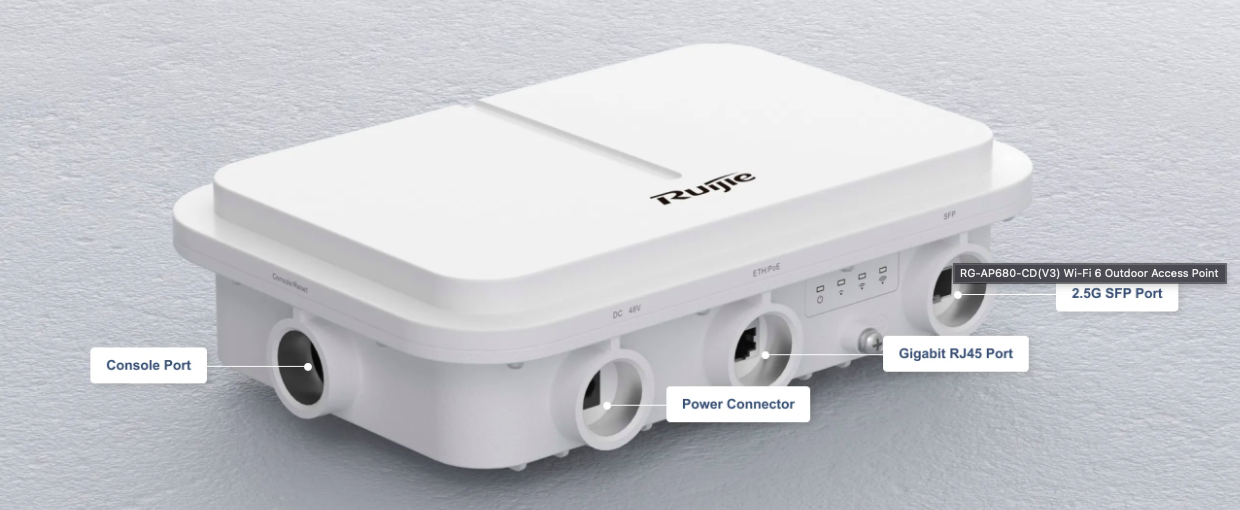RG-AP680-CD(V3), Wi-Fi 6 Dual-Radio 2.976 Gbps Outdoor Access Point, Directional Antennas Best Price In Dubai, UAE.
Availability:
In Stock
Outdoor scenarios covering school playgrounds, wireless cities, energy, and business malls
Highlight Features
- 2.5G SFP and Gigabit Ethernet Port for Flexible Networking
- Built-in Directional Antennas, Focused Coverage and Strong Signal
- Industrial-Grade Product Design
- 2.976 Gbps High Speed with 160 MHz Band
- Unified Cloud Management for Easy O&M
Description
Key Specification
RG-AP680-CD(V3) Wi-Fi 6 Outdoor Access Point
Outdoor AP with Full Functions

Industrial-Grade Product Design
IP68 dustproof and waterproof

Specifications
Hardware Specifications
| Hardware Specifications |
RG-AP680-CD(V3) |
| 802.11n |
Four spatial streams ● Radio 1 – 2.4 GHz: 2x2 MU-MIMO, two spatial streams ● Radio 2 – 5 GHz: 4x4 MU-MIMO, two spatial streams Channels: ● Radio 1 – 2.4 GHz: 20 MHz and 40 MHz ● Radio 2 – 5 GHz: 20 MHz and 40 MHz Combined peak data rate: 0.6 Gbps ● Radio 1 – 2.4 GHz: 6.5 Mbps to 300 Mbps (MCS0 to MCS15 ) ● Radio 2 – 5 GHz: 6.5 Mbps to 300 Mbps (MCS0 to MCS15) Radio technologies: Orthogonal Frequency-Division Multiplexing (OFDM) Modulation types: BPSK, QPSK, 16-QAM, 64-QAM, 256-QAM Packet aggregation: ● Aggregate MAC Protocol Data Unit (A-MPDU) ● Aggregate MAC Service Data Unit (A-MSDU) Dynamic Frequency Selection (DFS) Cyclic Delay/Shift Diversity (CDD/CSD) Maximum Ratio Combining (MRC) Space-Time Block Coding (STBC) Low-Density Parity Check (LDPC) Transmit beam-forming (TxBF) |
| 802.11ac |
Two spatial streams ● Radio 2 – 5 GHz: 2x2 MU-MIMO, two spatial streams Channels: ● Radio 2 – 5 GHz: 20 MHz, 40 MHz, 80 MHz, and 160 MHz Combined peak data rate: 1.733 Gbps ● Radio 2 – 5 GHz: 6.5 Mbps to 1.733 Gbps (MCS0 to MCS9) Radio technologies: Orthogonal Frequency-Division Multiplexing (OFDM) Modulation types: BPSK, QPSK, 16-QAM, 64-QAM, 256-QAM Packet aggregation: ● Aggregate MAC Protocol Data Unit (A-MPDU) ● Aggregate MAC Service Data Unit (A-MSDU) Dynamic Frequency Selection (DFS) Cyclic Delay/Shift Diversity (CDD/CSD) Maximum Ratio Combining (MRC) Space-Time Block Coding (STBC) Low-Density Parity Check (LDPC) Transmit beam-forming (TxBF) |
| 802.11ax |
Four spatial streams ● Radio 1 – 2.4 GHz: 2x2 uplink/downlink MU-MIMO, two spatial streams ● Radio 2 – 5 GHz: 2x2 uplink/downlink MU-MIMO, two spatial streams Channels: ● Radio 1 – 2.4 GHz: 20 MHz and 40 MHz ● Radio 2 – 5 GHz: 20 MHz, 40 MHz, 80 MHz, and 160 MHz Combined peak data rate: 2.976 Gbps: ● Radio 1 – 2.4 GHz: 8.6 Mbps to 0.574 Gbps (MCS0 to MCS11) ● Radio 2 – 5 GHz: 8.6 Mbps to 2.402 Gbps (MCS0 to MCS11) Radio technologies: uplink/downlink Orthogonal Frequency-Division Multiple Access (OFDMA) Modulation types: BPSK, QPSK, 16-QAM, 64-QAM, 256-QAM, 1024-QAM Packet aggregation: ● Aggregate MAC Protocol Data Unit (A-MPDU) ● Aggregate MAC Service Data Unit (A-MSDU) Dynamic Frequency Selection (DFS) Cyclic Delay/Shift Diversity (CDD/CSD) Maximum Ratio Combining (MRC) Space-Time Block Coding (STBC) Low-Density Parity Check (LDPC) Transmit beam-forming (TxBF) WPA3 |
| Antenna |
Wi-Fi ● 2.4 GHz: two built-in directional antennas, the max. antenna gain is 9 dBi. ● 5 GHz: two built-in directional antennas, the max. antenna gain is 9 dBi. Bluetooth ● One integrated vertically polarized omnidirectional antenna, the max. antenna gain is 4.5 dBi. |
| Port |
1 x 2.5GE SFP port 1 x 10/100/1000Base-T RJ45 Ethernet port with auto-negotiation 1 x RJ45 console port (serial console port) 1 x Bluetooth 5.0 |
| Status LED |
1 x multi-color system status LED ● AP power-on status ● Software initialization status and upgrade status ● Uplink service interface status ● Wireless user online status ● CAPWAP tunnel timeout ● Specific AP locating Three single-color signal strength LEDs: ● Whether bridging is enabled ● Whether bridging is successful ● Wireless signal strength after successful bridging |
| Button |
1 x Reset button ● Press the button for shorter than 2 seconds. Then the device restarts. ● Press the button for longer than 5 seconds. Then the device restores to factory settings. |
| Dimensions (W x D x H) |
Main unit: 251 mm x 168 mm x 64 mm (9.88 in. x 6.61 in. x 2.52 in.) Shipping: 405 mm x 232 mm x 325 mm (15.94 in. x 9.13 in. x 12.8 in.) |
| Weight |
Main unit: 1.5 kg (3.31 lbs) Mounting bracket: 0.2 kg (0.44 lbs) Shipping: 2.92 kg (6.44 lbs) |
| Mounting |
Wall- or pole-mounting (a mounting bracket is delivered with the main unit) |
| Input power supply |
The AP supports the following two power supply modes: ● 48 V DC/0.35 A power input over DC connector: The DC connector accepts 2.0 mm/6.3 mm center-positive circular plug. A DC power supply needs to be purchased independently. ● PoE input over ETH/PoE: The power source equipment (PSE) complies with IEEE 802.3af/at standard (PoE/PoE+). Note: If both DC power and PoE are available, DC power is preferred. |
| Power consumption |
Maximum power consumption: 12.95 W ● DC power: 12.95 W ● 802.3at (PoE+): 12.95 W ● 802.3af (PoE): 12.95 W ● Idle mode: 6.0 W |
| Environment |
Storage temperature: –40°C to +85°C (–40°F to +185°F) Storage humidity: 0% RH to 100% RH (non-condensing) Operating temperature: –40°C to +65°C (-40°F to +149°F) Operating humidity: 0% RH to 100% RH (non-condensing) At an altitude between 3,000 m (9,842.52 ft.) and 5,000 m (16,404.20 ft.), every time the altitude increases by 166 m (546 ft.), the maximum temperature decreases by 1°C (1.8°F). |
| Mean Time Between Failure (MTBF) |
200,000 hours (22 years) at the operating temperature of 25°C (77°F) |
| System memory |
512 MB DRAM, 128 MB flash |
| Transmit power |
2.4 GHz ● Max. transmit power: 28 dBm (631mW) ● Minimum transmit power: 10 dBm (10 mW) 5 GHz ● Max. transmit power: 28 dBm (631mW) ● Minimum transmit power: 10 dBm (10 mW) Note: The transmit power adjusted in percentage. The transmit power is limited by local regulatory requirements. |
The following table lists the radio frequency performance of Wi-Fi including different frequency bands, protocols, and date rates. It is country-specific, and Ruijie Networks reserves the right of interpretation.
| Radio Frequency Performance |
RG-AP680-CD(V3) |
||
| Frequency Band and Protocol |
Data Rate |
Max. Transmit Power per Transmit Chain |
Max. Receive Sensitivity per Receive Chain |
| 2.4 GHz, 802.11b |
1 Mbps |
25 dBm |
–92 dBm |
| 2 Mbps |
25 dBm |
–82 dBm |
|
| 5.5 Mbps |
25 dBm |
–84 dBm |
|
| 11 Mbps |
25 dBm |
–78 dBm |
|
| 2.4 GHz, 802.11g |
6 Mbps |
25 dBm |
–84 dBm |
| 24 Mbps |
23 dBm |
–74 dBm |
|
| 36 Mbps |
23 dBm |
–72 dBm |
|
| 54 Mbps |
20 dBm |
–67 dBm |
|
| 2.4 GHz, 802.11n (HT20) |
MCS0 |
25 dBm |
–84 dBm |
| MCS7 |
20 dBm |
–66 dBm |
|
| 2.4 GHz, 802.11n (HT40) |
MCS0 |
25 dBm |
–79 dBm |
| MCS7 |
20 dBm |
–63 dBm |
|
| 2.4 GHz, 802.11ax (HE20) |
MCS0 |
25 dBm |
–84dBm |
| MCS11 |
18 dBm |
–54 dBm |
|
| 2.4 GHz, 802.11ax (HE40) |
MCS0 |
25 dBm |
–80 dBm |
| MCS11 |
18 dBm |
–51 dBm |
|
| 5 GHz, 802.11a |
6 Mbps |
25 dBm |
–84 dBm |
| 24 Mbps |
23 dBm |
–74 dBm |
|
| 36 Mbps |
23 dBm |
–72 dBm |
|
| 54 Mbps |
20 dBm |
–67 dBm |
|
| 5 GHz, 802.11n (HT20) |
MCS0 |
25 dBm |
–84 dBm |
| MCS7 |
20 dBm |
–66 dBm |
|
| 5 GHz, 802.11n (HT40) |
MCS0 |
25 dBm |
–81 dBm |
| MCS7 |
20 dBm |
–63 dBm |
|
| 5 GHz, 802.11ac (VHT20) |
MCS0 |
25 dBm |
–84 dBm |
| MCS9 |
19 dBm |
–61 dBm |
|
| 5 GHz, 802.11ac (VHT40) |
MCS0 |
25 dBm |
–81 dBm |
| MCS9 |
19 dBm |
–56 dBm |
|
| 5 GHz, 802.11ac (VHT80) |
MCS0 |
25 dBm |
–78 dBm |
| MCS9 |
19 dBm |
–53 dBm |
|
| 5 GHz, 802.11ax (HE20) |
MCS0 |
25 dBm |
–84 dBm |
| MCS11 |
18 dBm |
–54 dBm |
|
| 5 GHz, 802.11ax (HE40) |
MCS0 |
25 dBm |
–81 dBm |
| MCS11 |
18 dBm |
–51 dBm |
|
| 5 GHz, 802.11ax (HE80) |
MCS0 |
25 dBm |
–78 dBm |
| MCS11 |
18 dBm |
–48 dBm |
|
| 5 GHz, 802.11ax (HE160) |
MCS0 |
25 dBm |
–73 dBm |
| MCS11 |
18 dBm |
–43 dBm |
|
Software Specifications
| Basic Function |
RG-AP680-CD(V3) |
| Applicable software version |
RGOS11.9(6)W2B4 or later |
| WLAN |
|
| Max. number of associated STAs |
1024 (up to 512 STAs per radio) |
| Max. number of BSSIDs |
32 (up to 16 BSSIDs per radio) |
| Max. number of WLAN IDs |
16 |
| STA management |
SSID hiding Band steering Each SSID can be configured with the authentication mode, encryption mechanism, and VLAN attributes independently. Remote Intelligent Perception Technology (RIPT) Intelligent load balancing based on the STA quantity or traffic Rate set settings Intelligent STA identification |
| STA limiting |
SSID-based STA limiting Radio-based STA limiting |
| Bandwidth limiting |
STA/SSID/AP-based rate limiting |
| CAPWAP |
IPv4/IPv6 CAPWAP Layer 2 and Layer 3 topology between an AP and an AC An AP can automatically discover the accessible AC. An AP can be automatically upgraded through the AC. An AP can automatically download the configuration file from the AC. CAPWAP through NAT |
| Data forwarding |
Centralized and local forwarding |
| Wireless roaming |
Layer 2 and Layer 3 roaming |
| Wireless locating |
MU and TAG device locating |
| Security and Authentication |
|
| Authentication and encryption |
Remote Authentication Dial-In User Service (RADIUS) EXEC authorization, specifying the source IP address of RADIUS packets, and built-in authentication server PSK and web authentication QR code-based guest authentication, SMS authentication, and MAC address bypass (MAB) authentication Data encryption: WEP (64/128 bits), WPA (TKIP), WPA-PSK, WPA2 (AES), WPA3-Enterprise, WPA3-Individual |
| Data frame filtering |
Allowlist, static blocklist, and dynamic blocklist |
| WIDS |
Wireless Intrusion Detection System(WIDS) User isolation |
| ACL |
IP standard ACL, MAC extended ACL, IP extended ACL, and expert-level ACL IPv6 ACL Time range-based ACL ACL based on a Layer 2 interface ACL based on a Layer 3 interface Ingress ACL based on a wireless interface Dynamic ACL assignment based on 802.1X authentication (used with the AC) ACL REMARK |
| CPP |
CPU Protect Policy (CPP) |
| NFPP |
Network Foundation Protection Policy (NFPP) |
| Routing and Switching |
|
| MAC |
Static and filtered MAC addresses MAC address table size: 1,024 Max. number of static MAC addresses: 1,024 Max. number of filtered MAC addresses: 1,024 |
| Ethernet |
Jumbo frame length: 1518 Full-duplex and half-duplex modes of interfaces IEEE802.1p and IEEE802.1Q |
| VLAN |
Interface-based VLAN assignment Max. number of SVIs: 200 Max. number of VLANs: 4,094 VLAN ID range: 1–4,094 |
| ARP |
ARP entry aging, gratuitous ARP learning, and proxy ARP Max. number of ARP entries: 1,024 ARP check |
| IPv4 services |
Static and DHCP-assigned IPv4 addresses NAT, FTP ALG and DNS ALG |
| IPv6 services |
IPv6 addressing, Neighbor Discovery (ND), ICMPv6, IPv6 ping IPv6 DHCP client |
| IP routing |
IPv4/IPv6 static route Max. number of static IPv4 routes: 1,024 Max. number of static IPv6 routes: 1,000 |
| Multicast |
Multicast-to-unicast conversion |
| VPN |
PPPoE client IPsec VPN |
| Network Management and Monitoring |
|
| Network management |
NTP server and NTP client SNTP client SNMPv1/v2c/v3 Fault detection and alarm Information statistics and logging |
| Network management platform |
Web management (Eweb) |
| User access management |
Telnet, SSH, FTP client, and FTP management |
| Switchover among Fat, Fit, and cloud modes |
When the AP works in Fit mode, it can be switched to Fat mode through an AC. When the AP works in Fat mode, it can be switched to Fit mode through the console port or Telnet mode. When the AP works in cloud mode, it can be managed through Ruijie Cloud. |


-228x228.png)
-500x500.png)


Reviews (0)